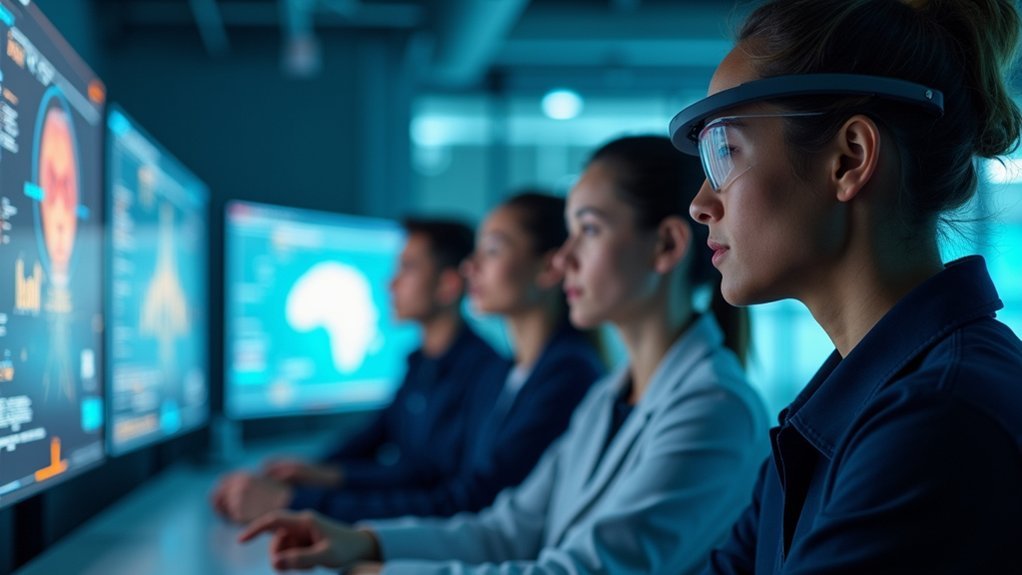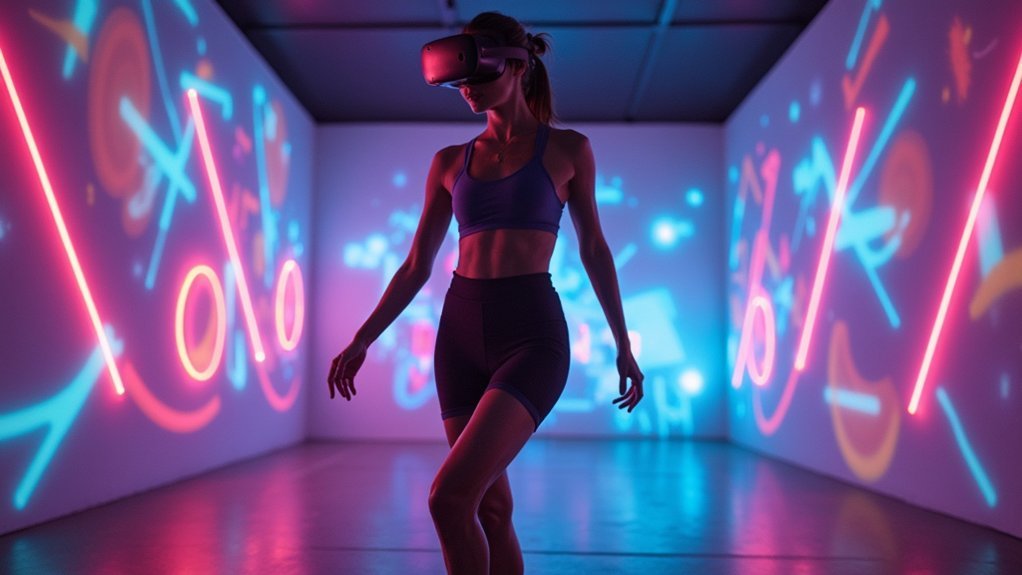Eye tracking revolutionizes training simulations by providing real-time insights into your cognitive load and attention patterns that traditional methods can’t detect. You’ll receive instant feedback during live training sessions, allowing immediate corrections before errors become ingrained habits. The technology analyzes your gaze patterns to create personalized learning pathways, reducing training time by up to 30% while enhancing safety through error prediction. Continue exploring to discover how this transforms your entire training experience.
Real-Time Gaze Monitoring During Training Sessions
When you’re training others in high-stakes environments, real-time gaze monitoring transforms how you understand and respond to their learning process. Through eye tracking technology, you’ll detect precisely where trainees struggle the moment it happens, enabling immediate habit-building and on-the-spot corrections that prevent errors from becoming ingrained patterns.
This powerful capability allows you to assess how trainees process information in real-time, giving you detailed attention analysis that reveals their cognitive load and focus patterns.
You’ll understand exactly what captures their attention and what they’re missing, enabling you to tailor your teaching strategies to each individual’s needs. Training simulations become more effective as you identify critical moments requiring emphasis, ultimately reducing training hours while optimizing learning outcomes through targeted interventions.
Cognitive Load Assessment and Mental State Analysis
Beyond simply tracking where trainees look, eye tracking technology provides a window into their cognitive state by analyzing fixation durations, pupil dilation, and gaze patterns to reveal mental workload in real-time. This cognitive load assessment enables trainers to identify when you’re experiencing overload or insufficient engagement during simulations.
| Cognitive State | Eye Movement Indicators |
|---|---|
| High Mental Load | Longer fixations, reduced blink rate |
| Cognitive Overload | Erratic gaze patterns, pupil dilation |
| Low Engagement | Shorter fixations, wandering gaze |
| Ideal Focus | Steady patterns, appropriate durations |
Eye movement data combined with heart rate monitoring creates thorough mental state profiles. This information drives personalized training adjustments, ensuring instruction matches your unique cognitive demands. Real-time feedback allows immediate corrections, while struggle pattern identification guides targeted interventions for enhanced performance.
Personalized Learning Pathways Through Eye Movement Data
Since each trainee’s visual attention patterns reveal unique learning preferences and cognitive processing styles, eye tracking technology creates truly individualized training experiences that adapt to your specific needs.
Your fixation durations and gaze patterns reveal exactly where you’re struggling, enabling trainers to design personalized learning pathways that target your weak points instead of following generic curricula.
Training simulators equipped with eye tracking dramatically reduce your learning time by focusing on critical improvement areas rather than forcing you through unnecessary content.
You’ll receive real-time feedback on your attention levels and cognitive load, allowing immediate adjustments to prevent overwhelm.
This tailored approach doesn’t just improve your individual performance—it transforms entire training programs into efficient, responsive systems that maximize learning outcomes across aviation and other high-stakes industries.
Enhanced Safety Through Error Prediction and Prevention
You can leverage eye tracking technology to predict when trainees are about to make critical errors by analyzing their gaze patterns and cognitive overload indicators.
This enables you to implement immediate safety interventions before mistakes occur, rather than waiting to correct them afterward.
Predicting Human Errors
When trainees’ eyes wander to irrelevant displays or fixate too long on single instruments, eye tracking technology catches these telltale signs of impending errors before they escalate into dangerous mistakes. This predictive capability transforms training simulations by identifying problematic gaze patterns that typically precede poor decisions or missed critical information.
| Warning Sign | Predicted Error |
|---|---|
| Extended fixation on single gauge | Missing system alerts |
| Rapid scanning without focus | Information overload |
| Gaze avoidance of key displays | Neglecting critical data |
| Attention drift to irrelevant areas | Loss of situational awareness |
| Delayed visual response patterns | Slow reaction times |
You’ll receive real-time feedback when your attention patterns suggest potential mistakes, allowing instructors to intervene immediately and redirect your focus to essential elements before errors occur.
Proactive Safety Interventions
As eye tracking technology identifies risky gaze patterns in real-time, instructors can implement immediate safety interventions that prevent minor attention lapses from becoming catastrophic errors.
You’ll benefit from trainers who can detect cognitive overload moments before they compromise your performance, allowing for timely corrections that enhance your situational awareness. This proactive approach transforms pilot training by shifting focus from reactive corrections to preventive measures.
When you’re experiencing attention drift during critical flight phases, eye tracking alerts instructors instantly, enabling targeted interventions.
You’ll develop heightened awareness skills through this continuous monitoring system. These proactive safety interventions create a safer training environment where potential mistakes are addressed before they manifest, ultimately producing highly skilled operators who maintain exceptional safety standards throughout their aviation careers.
Non-Intrusive Integration in Cockpit and Vehicle Simulators
Modern eye tracking systems seamlessly integrate into cockpit and vehicle simulators without requiring you to wear glasses, headgear, or any additional equipment. This non-intrusive approach keeps you comfortable while maintaining complete immersion in your training simulations.
You’ll experience immediate setup benefits since the technology requires no calibration, allowing you to start training sessions instantly.
The 3D camera technology functions effectively even in low-light conditions, ensuring consistent eye tracking performance regardless of your training environment. You won’t face distractions from cumbersome equipment, letting you focus entirely on mastering critical skills.
Real-time feedback on your visual attention patterns helps instructors identify improvement areas during sessions. This seamless integration revolutionizes how you learn, providing valuable gaze data without compromising your natural simulator experience or training effectiveness.
Immediate Feedback and Performance Optimization
While traditional training methods rely on post-session debriefs, eye tracking technology transforms your learning experience by delivering instant feedback during live simulations. This immediate feedback enables real-time corrections that dramatically enhance your skill development and reduce overall training time.
Eye tracking facilitates performance optimization through three key mechanisms:
- Real-time gaze analysis – Trainers identify struggle areas instantly, providing targeted guidance when you need it most.
- Cognitive load assessment – Training content adjusts dynamically based on your focus levels, reducing distractions and improving concentration.
- Emergency prioritization training – You’ll develop critical decision-making skills for high-pressure situations through guided attention management.
This immediate feedback system builds positive training habits while maximizing engagement and retention of essential skills throughout your simulation experience.
Advanced Attention Span Analysis for Complex Scenarios
Complex aviation scenarios demand split-second decisions and unwavering focus, yet traditional assessment methods can’t capture the nuanced attention patterns that separate skilled pilots from novices.
Eye tracking revolutionizes this assessment by precisely measuring your attention span through gaze pattern analysis, revealing exactly how long you focus on critical instruments during high-pressure situations.
Eye tracking reveals precise attention patterns during critical flight moments, exposing exactly where pilots focus when seconds matter most.
This technology identifies cognitive overload moments when you struggle to process multiple stimuli simultaneously. By analyzing fixation durations, trainers pinpoint where you might overlook essential information, enabling targeted interventions that sharpen your situational awareness.
Eye tracking transforms training simulations into adaptive learning environments that respond to your individual attention allocation patterns. This data-driven approach guarantees critical tasks receive adequate focus while optimizing training content for maximum effectiveness in complex scenarios.
Reduced Training Hours and Operational Costs
You’ll discover that eye tracking technology transforms pilot training economics by delivering personalized feedback that accelerates your learning curve and cuts training hours considerably.
Your organization can optimize resource management by monitoring real-time gaze patterns, which eliminates wasted simulator time and guarantees every training session targets specific improvement areas.
You’ll also reduce long-term operational costs through enhanced error prevention, as eye tracking helps you develop proper visual scanning habits that minimize costly mistakes during actual flight operations.
Accelerated Learning Through Personalization
Because every pilot learns differently, eye tracking technology revolutionizes training by analyzing your unique gaze patterns and attention behaviors to create truly personalized training experiences.
Instructors can now identify exactly where you struggle and tailor content specifically to your needs, dramatically accelerating your learning process.
Eye tracking transforms training programs through:
- Cognitive Load Analysis – Your eye movements reveal when you’re overwhelmed, allowing instructors to adjust difficulty levels in real-time.
- Attention Span Optimization – Training sessions adapt to your natural focus patterns, maximizing retention during peak concentration periods.
- Immediate Habit Correction – Real-time feedback identifies poor scanning techniques instantly, preventing bad habits from forming.
This personalized training approach cuts your training hours by up to 30% while ensuring you master critical cockpit skills faster than traditional methods allow.
Optimized Resource Management Efficiency
Eye tracking technology delivers measurable returns on your training investment by considerably reducing both time and costs.
When you implement this technology in your training simulations, you’ll identify struggling areas instantly, enabling targeted interventions that cut unnecessary practice hours. Your trainers can optimize information timing and presentation based on real gaze patterns, eliminating wasted learning cycles.
Real-time monitoring provides immediate corrections, preventing skill development delays that typically drain resources. You’ll also gain cognitive load insights, allowing content adjustments that prevent trainee overstimulation and maintain peak learning efficiency.
Pilot training studies demonstrate proficiency achievement in considerably fewer sessions when eye tracking guides instruction. This translates directly into reduced instructor time, facility usage, and equipment costs while maintaining superior training outcomes.
Error Prevention Cost Savings
When training errors compound into operational mistakes, the financial consequences extend far beyond initial program costs.
Eye tracking technology delivers substantial error prevention cost savings by identifying and addressing performance issues before they become expensive operational problems.
You’ll see immediate financial benefits through:
- 30% reduction in error rates – Research demonstrates eye tracking can cut training mistakes by nearly one-third.
- Minimized accident-related costs – Enhanced safety protocols reduce expensive mishaps during training and operations.
- Eliminated repetitive training expenses – Real-time feedback prevents costly retraining cycles.
Improved Human-Automation Interaction Design
As pilots interact with increasingly sophisticated cockpit automation, eye tracking technology transforms how these systems respond to human attention patterns.
You’ll experience adaptive automation that monitors where you’re looking and adjusts information presentation accordingly. When you focus on critical instruments during emergency procedures, the system recognizes your gaze patterns and prioritizes essential data delivery.
Eye tracking revolutionizes human behavior analysis by providing real-time feedback on your attention levels during complex tasks. This technology enhances training methods through immediate insights into cognitive load and engagement patterns.
You’ll benefit from cockpit designs that anticipate your needs, reducing confusion and frustration while supporting better decision-making. The result is seamless human-automation interaction that responds intelligently to your visual attention, creating more intuitive and safer flight operations.
Evidence-Based Training Content Adaptation
Training content adapts intelligently when eye tracking data reveals your unique learning patterns and cognitive processing style. Your real-time gaze movements provide trainers with precise insights into your cognitive load and attention distribution, allowing immediate customization of instructional materials to match your processing capabilities.
Eye tracking in training simulations transforms content adaptation through three key mechanisms:
- Difficulty identification – Analyzing your eye movement patterns pinpoints areas requiring additional focus or simplified presentation.
- Immediate feedback integration – Real-time gaze data triggers instant adjustments to content delivery, enhancing your engagement and comprehension.
- Retention optimization – Customized training scenarios based on your visual interaction patterns markedly improve understanding of complex information.
This evidence-based approach guarantees training content evolves dynamically with your learning needs.
Situational Awareness Enhancement for Critical Skills Development
Since critical decisions in high-stakes environments often depend on split-second recognition of essential cues, eye tracking technology revolutionizes how you develop situational awareness during training simulations.
When you’re learning to navigate complex scenarios, instructors can monitor exactly where you focus your gaze, identifying whether you’re missing critical information that could impact safety and performance.
The technology analyzes your gaze patterns to reveal how effectively you’re processing situational cues, enabling trainers to provide tailored interventions that sharpen your decision-making skills under pressure.
Real-time feedback allows instructors to address attention lapses immediately, while cognitive load measurements help optimize training scenarios.
Instant feedback and cognitive load data enable trainers to fine-tune scenarios for optimal learning without overwhelming trainees.
This guarantees you develop essential situational awareness without becoming overwhelmed, creating more effective learning environments for critical skill acquisition.
Frequently Asked Questions
What Are the Advantages of Eye Tracking Technology?
You’ll measure cognitive load in real-time, identify struggling areas through gaze patterns, reduce training costs, receive immediate feedback for corrections, and enhance safety by predicting errors before they occur.
Why Is Visual Tracking Important?
You’ll measure cognitive load and optimize learning by tracking where trainees focus their attention. Visual tracking reveals engagement levels, identifies critical simulation areas, and enables real-time training adjustments for better outcomes.
Why Is Eye Tracking Good?
You’ll benefit from eye tracking’s ability to measure your cognitive load, identify missed information, provide real-time feedback, predict potential errors, and integrate seamlessly without distracting you during training sessions.
What Are the Applications of Eye Tracking Technology in Educational Research?
You can analyze students’ attention patterns, identify learning difficulties, optimize instructional materials, understand individual learning styles, measure cognitive load, provide real-time feedback, and develop adaptive learning technologies that respond to visual behaviors.
In Summary
You’re witnessing a fundamental shift in how training simulations operate. Eye tracking technology isn’t just monitoring where you look—it’s revolutionizing your entire learning experience. You’ll train more efficiently, develop critical skills faster, and operate in safer environments. Your cognitive patterns guide personalized pathways while reducing costs and training time. This technology transforms you from a passive trainee into an active participant in scientifically-optimized, evidence-based learning systems.





Leave a Reply